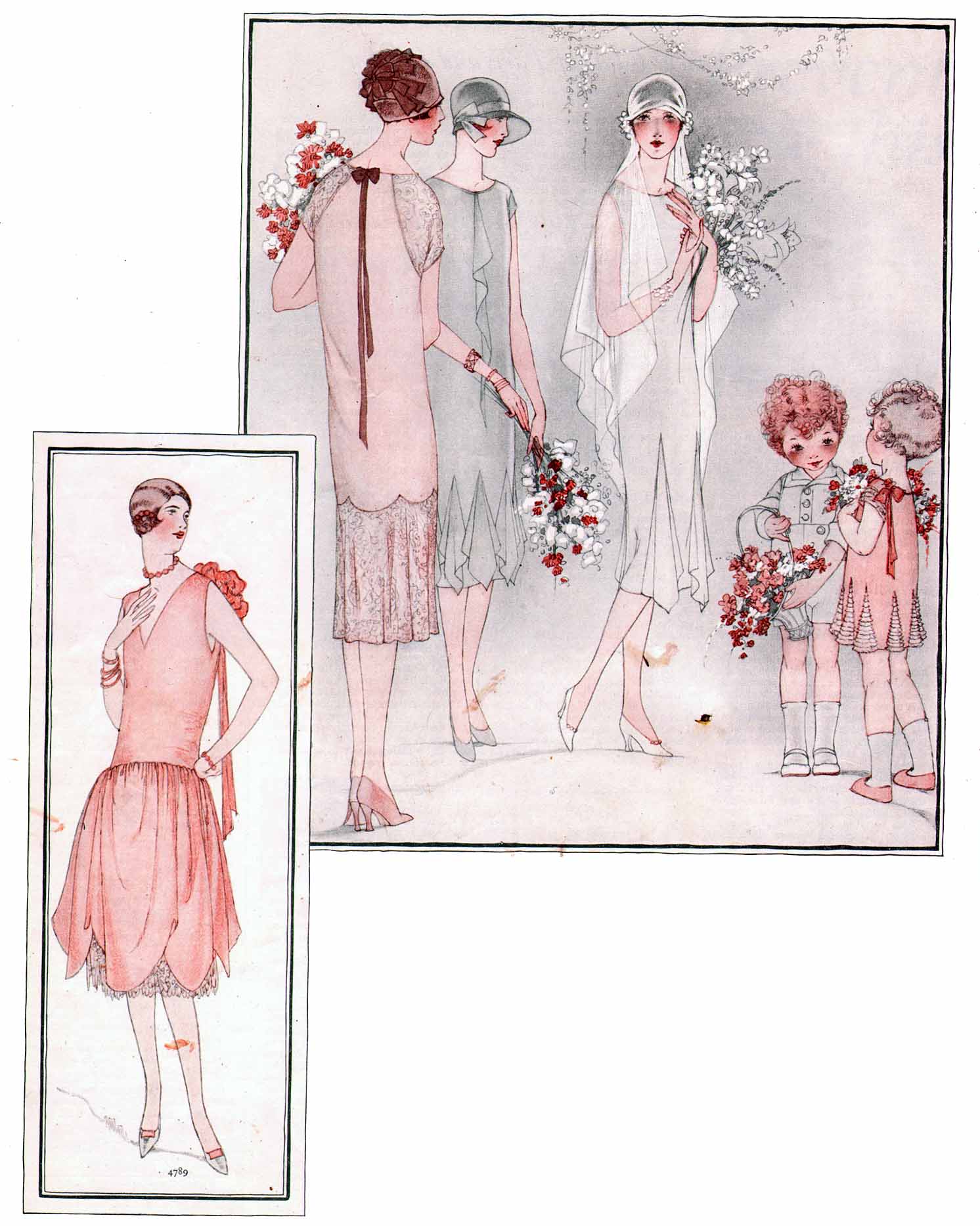
Bridal Fashions of the 1920s
This page contains a reprint of an article from The Ladies' Home Journal, September 1925. The
text on this page is transcribed from a period source. Any pattern numbers and prices are for research purposes only;
these patterns and garments are not available for purchase.
|
It’s a Smart
Parisian Trousseau and Any
Bride-to-Be Can Make It
from The Ladies' Home Journal, September 1925
The wedding gowns we see and covet are innumerable. Usually they appear in the Sunday supplements,
and we read the names of their extraordinary fortunate owners and think how pleasant it would be not to mind how
much anything cost. Once in a blue moon, however, luck is with us. And whether your calendar says so or not,
there’s a blue moon now.
Here are gowns for an entire wedding party and all the lovely things one wants for a trousseau, and,
by some unheard-of magic, the actual design for each one is given. That means they can be made, all of them, probably,
for less than one of those Sunday-supplement wedding gowns, and when they are made they will look just as lovely as the
heart of any bride could wish.
For herself, our bride chooses ivory chiffon, made with a round neck, and sleeveless—sizes 16 years,
36 to 44. The skirt is trimmed with six rippling godets fastened only at the top and, because there is said to be luck
in odd numbers, another ripples down from the right shoulder in back. Her tulle veil, hanging just below the waist, is
caught at the sides and across back with a half circle of artificial white flowers. Her slippers are of ivory satin and
are worn with sheer matching stockings.
|

|
|
For the maid of honor next to the bride a tawny yellow chiffon was selected. On her frock, too,
handkerchief points cascade around the skirt; but instead of another at one shoulder, she wears a becoming jabot frill.
The design is in sizes 16 years, 36 to 44. Her hat is of beige felt with yellow grosgrain ribbon, and her satin or kid
slippers and stockings match the dress.
|

|
The bridesmaid wears a dress of flowered chiffon in mauve and tan shades or of plain mauve chiffon and
cream-colored lace. The lace sleeves are a part of the yoke and there is a lace flounce attached in scalloped outline;
sizes 16 years, 36 to 42. A violet ribbon trails down the back and matches the bows on the mauve velours hat. Her
footgear is champagne-colored kid.
For the wee ring bearer, whose suit comes in sizes 2 to 10 years, choose white satin and white slippers
and stockings. His waist has a turned-down collar, and the straight little trousers button bravely all the way around.
The
flower girl wears pale yellow chiffon with yellow slippers and stockings and on her shoulder is a bow of brown satin ribbon.
Tiny godets are set in the skirt, and val lace trims them and the neck and sleeves; sizes 4 to 10 years.
|
|
For her trousseau, an evening gown such as the one in the illustration above (at lower left) was wisely chosen by
the bride. This comes in sizes 16 years, 36 to 40, and has the popular basque bodice and full-gathered skirt. Made of
taffeta in a pastel shade, it is particularly charming with silver lace ruffles beneath the scallops and a black velvet
flower with silver center placed on one shoulder.
On this illustration, at the left, is the bride’s general-wear dress, a light-weight twill or crêpe. The round neck
with string tie is one of the smart innovations, and this tie arrangement is also carried out on the cuffs of the long sleeves.
The back of dress, which has similar pointed tabs at each side, is in one straight piece; the front is in two pieces with circular
skirt section. Design comes in sizes 16 years, 36 to 42.
Next to this is a really “best” afternoon dress of georgette and lace. The V-shaped neck is finished with a
cravat and collar of lace, the shoulder seams are slightly fitted, and there are three small tucks at each shoulder. A knee flounce,
open at center front, adorns the skirt, This design is in sizes 16 years. 36 to 44.
Her second-best afternoon dress pictured below (at far left), to be worn with the separate coat at extreme right, is of black satin with a
white georgette jabot trimmed with black satin buttons. Full-length separate sections are attached to the kimono sleeves. Pockets
and a string belt are also included in the design, which comes in sizes 16 years, 36 to 44.
The ubiquitous sports dress, which is also worn as a “going-away” frock, third from right, is of tweed,
the blouse having a jabot of polka-dotted green-and-tan silk crêpe. One-piece set-in sleeves are full-length and the two-piece
|

|

|
skirt with kick plaits at side front is attached to a camisole top; sizes 16 years, 36 to 44.
Two views are sketched of the bride’s going-away coat—sizes 14 and 16 years, 36 to 44. In one we observe
closely the way in which the flare is thrown on side seams, both front and back. In the other we see the smart little notched
collar and the flared side pieces on pockets. There is one dart in each side front.
|
|
-The Ladies’ Home Journal, September, 1925
|
|
|
|
|
NEWS:






last updated 24 jul 2014/csb
|


